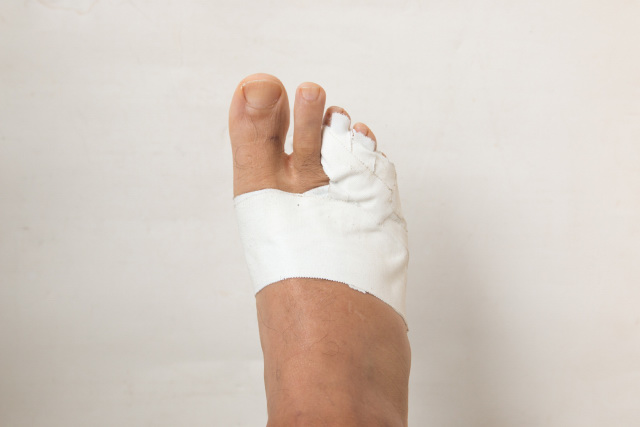Nothing is worse than breaking a toe, except maybe when it’s coming into pool season. Then, of course, soaking in the pool during a hot day is a must but is it possible with a broken toe?
Swimming with a broken toe is possible in some situations. It’s important to follow your doctor’s advice first. Whether or not it’s safe depends on the severity of the break, if you have a healing wound and if a plaster cast is required.
Before continuing, it’s essential to realize that the information in this article isn’t medical advice. Therefore, it’s best to consult your doctor for advice on swimming with a broken toe.

Article Contents
Benefits of Swimming for Injury Recovery
In the past, complete rest for weeks was the standard protocol for recovering after a fracture or other injury. However, doing so causes muscles to waste (muscle atrophy) and prolongs a full recovery back to your old self.
Swimming is a common rehabilitation therapy because of its weight-bearing qualities. It’s ideal for fractures, injuries, and chronic pain as water buoyancy reduces the impact of gravity on the body.
The feet are put through a lot and are vital for maintaining balance and movement, so fracturing a toe can significantly impact your day-to-day. However, swimming (with your doctor’s approval) is a perfect way to keep your muscles from wasting and help speed recovery.

Factors that Affect Swimming with Broken Toe
Before jumping into your pool, there are a few considerations to factor in. These include where the break is, the treatment you’re receiving, and what pool type you have.
Doctor’s Advice
Regardless of what factors you’re dealing with, follow your doctor’s advice and recovery timeline. If you want to swim to help aid recovery, make sure to consult with your physician or licensed professional (orthopedist or physical therapist) first.
Severity of Break
After following doctor guidelines, the most important factor is the location and severity of the break.
The fifth toe, otherwise known as the pinky, is often vulnerable to breaks, usually by catching it on something while the body twists away. But, although much sturdier, the big toe isn’t untouchable and can have a more prolonged effect on when you can swim again.
The big toe is the last point of contact when pushing off the pool wall/floor, so the toe must be recovered before it is used for your usual push-offs. In fact, it may be best to avoid all push-offs to make sure there is no chance of accidentally bumping your broken toe.
A potential workaround is to invest in a toe cap protector, which may help relieve pressure on the big toe inside (and outside) the pool. For instance:
Most breaks or fractures are usually treatable by ‘buddy taping’ the injured toe to its neighbor or securing a splint with bandages. However, if the fracture extends to the forefoot, you may need a walking cast or boot to offset the pressure on your break.
Dressings or Bandages
Most treatments for a broken toe involve dressings and bandages. A common practice is to splint or bind the fractured toe to its healthy neighbor using tape and a splint. The bandage may be secured with pins or medical tape.
Keeping your dressings and bandages clean and dry is crucial, particularly if the bone broke the skin or if surgery and stitches were needed. Even if you’re cleared for swimming, keeping the wound clean and dry is vital to prevent infection.
Unfortunately, even the most pristine pool harbors contaminants and bacteria that can prevent wound recovery.
Typical dressing/bandage materials may not be suitable for water use and require changing directly after pool use. Again, follow your physician’s treatment plan to re-dress and bandage your toe when cleared for swimming.
Cast or Boot
Needing a cast or a walking boot is usually in the case of a broken big toe or a fracture in the forefoot. Keeping the cast dry is crucial to keep its integrity intact. If you’re an avid swimmer, you can inquire with your doctor about waterproof casts. Or use a waterproof foot cast cover like this:
TKWC Inc Waterproof Foot Cast Cover
Walking boots tend to follow casts during recovery treatment. Again, walking boots aren’t typically waterproof. But, with your doctor’s approval, you may be able to remove the boot just before and after swimming safely.
But at this stage, experts recommend opting for gentle aqua exercise and water aerobics. Megan Lasson (U.S. Master Swimming Level 4 Coach) chose these options after a fibula fracture before returning to her routine.
Pool Type
An unexpected consideration to factor in is what type of water you have in your pool and if you want to have a soak in a hot tub.
On the whole, pool water won’t massively impact your broken toe. However, chlorine can irritate compound fractures at the wound site and slow healing.
If you have a saltwater system, you may have better luck at healing as the salt in the water acts as a vacuum, drawing out infected fluids. However, the salt content in a saltwater pool is much lower than in the ocean, so the salt may not have as strong an effect as sea swimming.
If you’re thinking of soaking in a hot tub, the heat can increase pain and inflammation as blood will rush to the area and increase swelling.
Again, check with your doctor before getting your wound wet.
Related Reading: Saltwater Vs Chlorine Pool | Are Salt Pools Better?
When Is It Safe to Swim After Breaking a Toe?
The location, severity of the fracture, and swimmer age will depend on recovery time and the return to the pool. Generally, recovery rates vary from 3-8 weeks.
Typical Recovery Rates
If you’re suffering from a stress fracture, you can typically expect a full recovery after 3-4 weeks.
However, if you completely broke your toe, you should expect a healing time of 4-6 weeks. And, if the fracture is in the forefoot or is a compound fracture (the bone broke skin), a typical recovery time is 6-8 weeks.
For regular or professional swimmers, taking this much time off from swimming isn’t possible. So, consult with your doctor if there are waterproof options for treatment and if swimming is possible.
Even if cleared, be mindful of how much pressure you put on your broken toe. For example, avoid flips, diving, or wall push-offs until the toe is completely healed. And for one Reddit swimmer, found kicking hurt their toe and chose to use a pull buoy while swimming.
However, if you prefer to err on caution, why not enjoy the water on one of the Best Giant Pool Floats while keeping your toe dry?
Swimmer Age and Health
The age and health of the swimmer who’s broken their toe will impact their recovery rate.
For example, children’s bones are more malleable and recover much quicker than adults. As a result, a child may only need two weeks for a stress fracture instead of 4 weeks for an adult.
If the swimmer is senior, their recovery rate after injury tends to be slower as the body has to work harder to repair, so it may take longer than usual to recover fully.
Another consideration is the swimmer’s overall health and medication. For instance, if they are in poor health or are taking immunosuppressive medication, recovery will take longer despite their age.
Checking with your doctor or child’s doctor is crucial for the best recommendations to follow for your particular situation.
Risks of Swimming Too Soon
The most significant risks of swimming too soon after breaking your toe are prolonging your recovery and potentially worsening the injury.
Keeping as much pressure off your toe as possible is crucial, particularly in the first few days or weeks. Although the buoyancy of water reduces stress on your feet, pushing off surfaces too soon can worsen the break and open surgery sites.
If you need stitches or surgery on your toe, swimming too soon will increase the likelihood of getting infections as bacteria can enter the open wound and wreak havoc.
Final Thoughts
Swimming is an excellent exercise for everyone, regardless of fitness level or health condition. However, there are times when swimming can do you more harm than good.
Luckily, with some care and your doctor’s consent, it is possible to swim with a broken toe.
Related Reading:
30 Things You Really Shouldn’t Do in a Pool
Ideal Swimming Pool Temperatures (A Complete List)





thank you and great article !